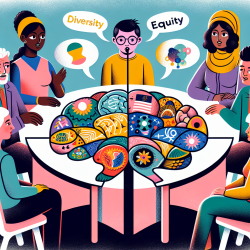Introduction
In the ever-evolving field of speech-language pathology, practitioners are increasingly called upon to address the diverse needs of the children they serve. A recent study titled Start the Way You Want to Finish: An Intensive Diversity, Equity, Inclusion Orientation Curriculum in Undergraduate Medical Education highlights the importance of integrating diversity, equity, and inclusion (DEI) into medical education. While the focus is on medical students, the principles and outcomes are highly applicable to speech-language pathologists (SLPs) working with children.
Understanding the Research
The research conducted by Davis et al. (2021) implemented a two-day intensive DEI curriculum for medical students, emphasizing relationship-building and communication skills. This approach not only prepared students to engage with patients from diverse backgrounds but also addressed implicit biases and promoted cultural humility.
Key Takeaways for Speech-Language Pathologists
SLPs can draw valuable insights from this research to enhance their practice:
- Embrace Experiential Learning: Incorporate experiential learning into professional development to foster understanding and empathy. This can be achieved through role-playing and sharing personal narratives, which help reduce implicit biases.
- Focus on Communication Skills: Develop relationship-centered communication skills that improve interactions with children and their families. Skills such as active listening, empathy, and open-ended questioning are crucial for effective therapy.
- Promote Cultural Humility: Move beyond cultural competence to embrace cultural humility. This involves a continuous self-reflective process to understand one's biases and the cultural dynamics that influence therapy outcomes.
- Address Implicit Bias: Implement training sessions that address implicit biases and microaggressions, creating a more inclusive environment for children from diverse backgrounds.
Implementing DEI in Speech-Language Pathology
To integrate DEI principles into practice, SLPs can take the following steps:
- Professional Development: Participate in workshops and seminars focused on DEI and communication skills. Encourage continuous learning and reflection on personal biases.
- Curriculum Integration: Collaborate with educational institutions to integrate DEI topics into speech-language pathology curricula, ensuring future practitioners are well-equipped to handle diverse cases.
- Peer Support and Mentorship: Establish peer support groups and mentorship programs that focus on DEI, allowing practitioners to share experiences and strategies for addressing diversity-related challenges.
- Community Engagement: Engage with diverse communities to better understand their needs and perspectives, tailoring therapy approaches to be culturally relevant and effective.
Conclusion
The integration of DEI principles into speech-language pathology is not just a moral imperative but a pathway to achieving better outcomes for children. By adopting the strategies highlighted in the research by Davis et al., SLPs can enhance their practice, ensuring that all children receive equitable and effective therapy. For those interested in further exploring the original research, please follow this link: Start the Way You Want to Finish: An Intensive Diversity, Equity, Inclusion Orientation Curriculum in Undergraduate Medical Education.










